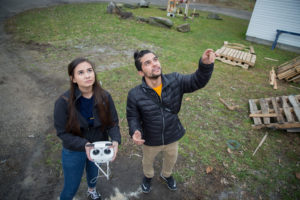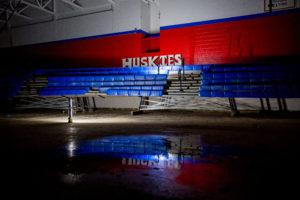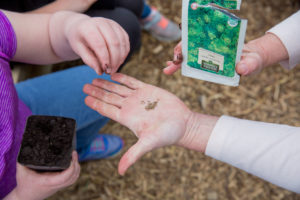By Aishina Shaffer and Bree McCullough
Twelve hundred homes washed away. Twenty-three deaths. Ten feet of water. The destruction caused by the 2016 West Virginia floods was seen far and wide.
One year later, while those affected by the flooding are still struggling to keep their heads above water, some headstrong students in Southern West Virginia public schools are working to better the communities that were quickly forgotten in the wake of the floods.
Journalism and strategic communications students at the West Virginia University (WVU) Reed College of Media collaborated over the spring 2017 semester to bring these stories of hope and resilience to life with immersive technology.
Virtual reality is a storytelling method that is just beginning to take root in the field of media. When viewed through a headset, the technology allows the wearer to be placed in a new environment. This was imperative to telling the stories of the students at Clay County High School, Herbert Hoover High School and Rainelle Elementary School.
WVU students took their 360 cameras to these schools and documented the projects, all of which focused on flood recovery. This is Hope 360.
Building the Future
Clay County, WV, was not one of the original counties President Barack Obama declared a major disaster area. It wasn’t until June 28—five days after the flood hit—that West Virginia Governor Earl Ray Tomblin requested that the disaster area be expanded to include Clay, Fayette, Monroe, Pocahontas, Roane, Summers and Webster counties. Of those seven counties, only five were granted the request. Clay County was one of them.

In the year following the floods, the people of Clay County banded together to clean up their community. The volunteers making perhaps the biggest contribution, however, have been the students in the career and technical education center at Clay County High School.
The high school offers students the opportunity to receive vocational training through the career and technical education center. They take classes learning carpentry, electrical, plumbing, engineering and web development skills. In a county where only 41.1 percent of high school graduates—approximately 39 students—enroll in a college or university, it’s paramount that students have the opportunity to gain skills that allow them to step directly into the workforce post-graduation.
During the 2016-17 school year, rather than work on independent projects, the students from each class collaborated to build a tiny house for one of the many families that were still displaced a year after the floods. They had a hand in each step of construction, from the blueprints to the final coat of paint.
After about six months, they gave the finished tiny house to the family of a peer who had been living in a shed on their property. Students and CTE faculty at Clay hope to continue the project in the next academic year.
That Teacher

Herbert Hoover High School in Kanawha County, WV, was completely lost in the flood, a fact that many people outside of the area forgot. Until they put on a headset.
By utilizing virtual reality, WVU students were able to transport wearers to the now condemned high school. The once lively high school is now empty, except for a single teacher showing where his art class used to be.
Art teacher Brian Barth dedicated his own time and money to develop a coding course for students prior to the flood, but all of his efforts were washed away. Even after losing so much, Barth is determined to provide his students with new opportunities and get back what they lost.
Virtual reality allowed Hope 360 to show that even a year later, these students are still without a school and reduced to four hours of instructional time each day at Elkview Middle School. Middle school and high school students were restricted this past year to learning their basic curriculum with no time for electives.
With the help of portable classrooms, Herbert Hoover High School students are guaranteed a full day of instructional time for the 2017-18 school year. With teachers like Barth cheering them on, students will once again have the opportunities they missed out on this past year.
Hope Grows Here
Of the three communities the WVU students visited last semester, Rainelle, WV, was perhaps hit the hardest. Passing through, the project group found homes left in ruin with spray-painted flood lines reaching the roof to show just how high the water had risen.
But those who were affected the most were the children.

The teachers at Rainelle Elementary School noticed troubling behavior from the children after they returned to school. They were stricken with fear every time it rained. Many would run to the windows to watch for raising water, and the school’s metal roof made thunderous noises as the rain fell.
A high tunnel sits behind the elementary school, through which the teachers saw an opportunity for the students to not only grow not just plants but grow as people.
With the help of a master gardener, gardening became an integral part of the curriculum for many classes at Rainelle. Students learned about photosynthesis and how to care for a plant. They actually grew their own vegetables that the cooks used in their cafeteria.
By watching the plants grow from tiny seeds into something they could eat, the children learned that water also brings life.
To learn more about Hope 360, follow the project as it continues in the fall 2017 semester by visiting wvhopestories.com or follow the WVU Media Innovation Center on Facebook and Twitter.
About the Authors
 Aishina Shaffer is the communications specialist for the School of Medicine at West Virginia University. Originally from Charleston, WV, she graduated cum laude with a bachelor’s degree in journalism in 2017. She is currently pursuing a master’s degree in integrated marketing communications at WVU.
Aishina Shaffer is the communications specialist for the School of Medicine at West Virginia University. Originally from Charleston, WV, she graduated cum laude with a bachelor’s degree in journalism in 2017. She is currently pursuing a master’s degree in integrated marketing communications at WVU.
 Bree McCullough is a communications intern for the Eberly College of Arts and Sciences at West Virginia University. Originally from Point Pleasant, WV, she is currently pursuing her bachelor’s degree in journalism at WVU and will graduate in 2018.
Bree McCullough is a communications intern for the Eberly College of Arts and Sciences at West Virginia University. Originally from Point Pleasant, WV, she is currently pursuing her bachelor’s degree in journalism at WVU and will graduate in 2018.







